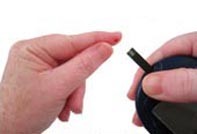Peer Reviewed
Feature Article Endocrinology and metabolism
Getting A1c under 7%. The KISS (’keep insulin safe and simple’) approach in type 2 diabetes
Abstract
Glycosylated haemoglobin (A1c) is an indicator of glycaemic control in people with diabetes. Its target value of below 7% can be achieved by first getting the fasting blood glucose level (BGL) to target, then the evening BGL and then any mealtime BGL increases.
Key Points
- A1c – the ‘gold standard’ for glycaemic control – reflects the relation between average blood glucose over the preceding few weeks and diabetic complications.
- In type 2 diabetes, the blood glucose profile can be divided into three components, each of which can be controlled by different strategies: fasting glycaemia, controlled by bedtime basal insulin; daytime blood glucose increment, controlled by morning basal insulin; and prandial increases, controlled by lower glycaemic load meals, increased physical activity, prandial acarbose or bolus insulin.
- Controlling preprandial blood glucose levels (BGLs) – i.e. the fasting blood glucose plus any daily basal increment – can result in large decreases in average BGL and A1c. Controlling the size of prandial increments ‘finetunes’ blood glucose control but will not greatly decrease overall glycaemia if preprandial values are on target.
- The KISS approach to controlling blood glucose with insulin involves first controlling the fasting BGL (‘First fix the fasting’), then the BGL before the evening meal (‘Then tackle tea’), then any mealtime BGL increases (‘Find the hidden hypers’) and finally looking at glycaemic control over a longer period (‘And check the A1c’).
Purchase the PDF version of this article
Already a subscriber? Login here.

